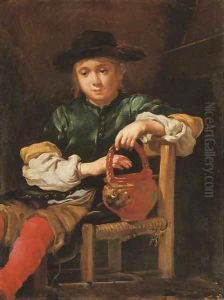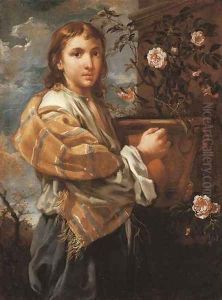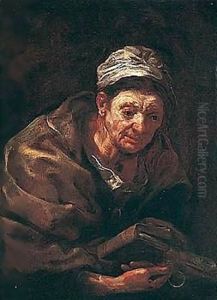Bernardo Keilhau Paintings
Bernardo Keilhau, better known as Bernardo Keil, was a notable Baroque painter of the 17th century, born in Copenhagen, Denmark. He was part of a family of artists, with his father, Eberhard Keil, also known as Eberhard Keilhau, being a successful painter who influenced Bernardo's artistic path.
Bernardo Keil's initial training was under the guidance of his father, who was a pupil of Rembrandt. This connection to Rembrandt is evident in Bernardo's early works, which showcase a strong influence from the Dutch master, particularly in his use of chiaroscuro and the treatment of subjects. After his formative training, Bernardo embarked on the traditional journey of a young artist of his time, traveling to Italy to further his studies and artistic development.
In Italy, Bernardo Keilhau adopted the name Bernardo Keil to better assimilate into the local culture. He settled in Rome, which was a vibrant center for art in the Baroque period, attracting artists from all over Europe. There, he became part of the circle of northern artists known as the 'Bentvueghels', a group that included many Dutch and Flemish artists living in Rome. His Italian contemporaries gave him the nickname 'Monsù Bernardo', a testimony to the respect he garnered in the Roman art community.
Keil's work in Rome was diverse, ranging from religious commissions to portraits and genre scenes. His style evolved during his Italian sojourn, incorporating influences from Caravaggio and the Bolognese School. This is evident in his more dynamic compositions, a heightened sense of naturalism, and a more sophisticated use of light and shadow. Despite his northern roots, Keil's work from this period is often indistinguishable from that of his Italian contemporaries due to his adept assimilation of local styles and techniques.
Bernardo Keil's success in Italy was significant, and he was able to establish a flourishing workshop. His work was sought after by patrons, and he trained several apprentices who would carry on his artistic legacy. Keil's paintings from his Roman period are considered his most important, and they remain a testament to the cultural exchange between northern European artists and the Italian tradition during the Baroque era.
Keilhau died in Rome in 1687, having spent the majority of his career in Italy. His contributions to the art of the Baroque period have been recognized by art historians, and his works can be found in various collections and museums across Europe. As a bridge between the Northern European and Italian artistic traditions, Bernardo Keilhau's legacy is one of cross-cultural artistic synthesis and the fostering of a pan-European Baroque aesthetic.


